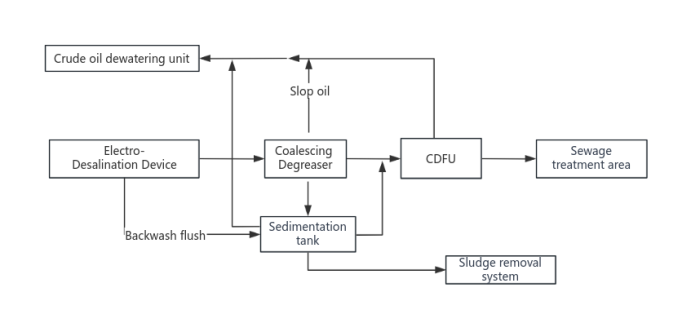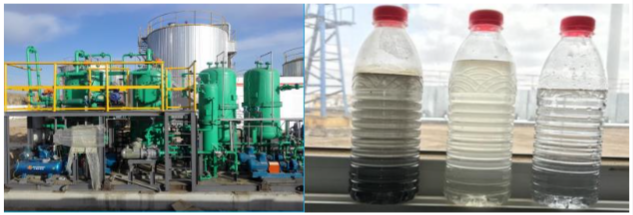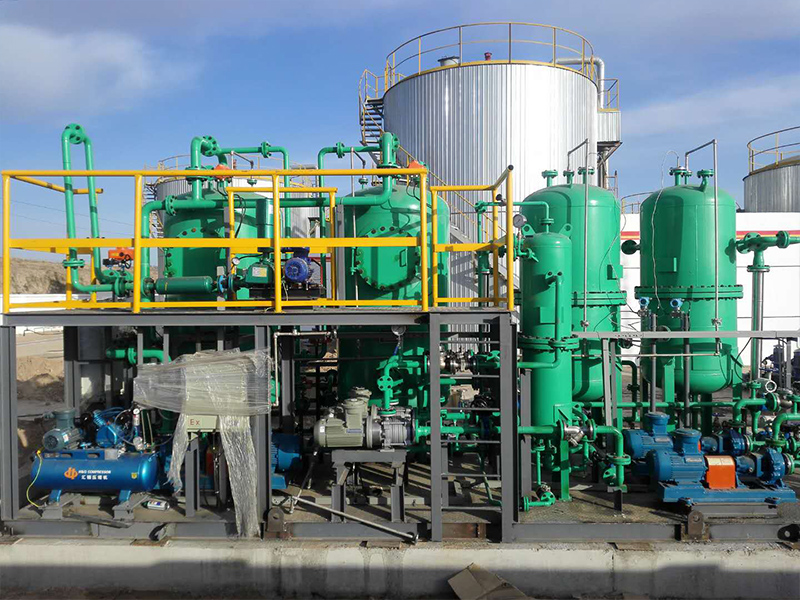Continuous Reduced Pressure Electrodesalination and Cutting Water Treatment
Product Detail
Process Introduction
The electrical desalination and cutting water process are characterized by high oil content, significant fluctuations, high levels of colloids and asphaltene, severe emulsification, and a small difference in oil-water density. These traits make it extremely difficult to handle and have been troubling refining companies for many years, yet a satisfactory solution has not been found. Presently, most domestic refineries employ gravity settling, cyclone oil removal, membrane filtration, and other treatment processes. However, based on on-site applications, the operating costs are high, and the treatment effectiveness is not ideal. This results in wastewater entering the sewage treatment plant with excessive oil content, significantly affecting the plant's compliance with discharge standards and the stability of wastewater reuse.
Developed independently, the comprehensive solution for electrical desalting wastewater is centered around patented technologies: the "High-Efficiency Aggregation Oil Remover" and the "CDFU (Centrifugal Dissolved Air Flotation)." This solution relies entirely on physical separation techniques, ensuring stable equipment operation, efficient treatment outcomes, minimal footprint, and consistent performance. Fully enclosed and pressurized, the system operates automatically, ensuring safety and environmental friendliness. The overall technology is at an advanced international level, allowing for online installation and deployment without interrupting the operation of the electrical desalting unit.

With an inlet oil content ranging from 0.5% to 5%, the outlet oil content is less than 50mg/L, achieving over 90% oil removal rate. Simultaneously, it separates crude oil with a water content of less than 1%, effectively processing wastewater while reclaiming a substantial quantity of high-quality crude oil. The implementation of this equipment comprehensively resolves the severe downstream wastewater treatment plant challenges caused by darkened and oil-laden desalted water. It ensures the stable operation of wastewater treatment plants, alleviating operational pressures and substantially reducing the handling costs of hazardous oily waste generated from crude oil entering the wastewater treatment plant. This approach generates substantial economic benefits while achieving both economic and environmental gains.
Technological Advantage
• Escaping the traditional separation mode solely based on the density difference between oil and water, relying instead on the density variance among gas-water and oil-gas-water. This allows oil removal to be less affected by the density of contaminated oil, significantly enhancing separation efficiency.
• Utilizing high-efficiency coalescence/tilted plate oil separators, characterized by high separation efficiency, strong shock resistance, low susceptibility to blockages, and low energy consumption.
• Employing an efficient and compact dissolved air flotation device, delivering high separation efficiency without the need for any chemical additives, effectively removing emulsified oil. This system ensures high reliability and stable processing performance.
• The entire processing technology demonstrates high oil removal efficiency, robust shock resistance, and reliability, guaranteeing consistent compliance with wastewater treatment plant requirements even in the face of severe fluctuations in oil content
Technical Comparison
No. | Project | Traditional Technique |
1 | Principle | Physical sedimentation/liquid-liquid centrifugation |
2 | Emulsified oil removal | Emulsified oil cannot be removed |
3 | Oil removal effect | The rate of water reaching the standard is low |
4 | Secondary handling Cost | The addition of chemicals can produce large amount of heavy waste oil and lead to high secondary treatment cost |
5 | Impact resistance | Poor impact resistance, water instability, poor adaptability |
6 | Automate | Large amount of chemicals and sludge (hazardous waste) , Non-enclosed operation, the exhaust gas is leaked, bringing secondary pollution, and there is a greater safety and environmental protection risk. |
7 | Anti-clogging | Easy to clog, clean regularly |
No | Project Project | SINOKLE Solustion SINOKLE Solustion |
1 | Principle | High efficiency coalescence + centrifugal separation + oil, gas, water three-phase separation |
2 | Emulsified oil removal | Removes most of the emulsified oil |
3 | Oil removal effect | Effluent stability up to standard |
4 | Secondary handling Cost | No chemical pure physical demulsification separation, recovery of high-quality crude oil, no secondary processing costs |
5 | Impact resistance | Good impact resistance, good adaptability |
6 | Automate | Fully automated operating, environment friendly, safety and environmental protection |
7 | Anti-clogging | Difficult to clog, no regular cleaning |
Application Case


